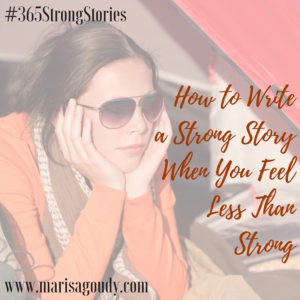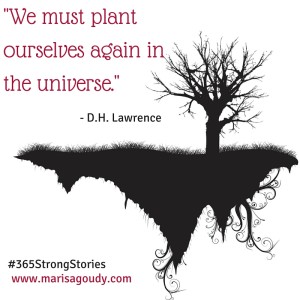
BLOG
How to Write a Strong Story When You Feel Less Than Strong
 Making blogging, newsletter, and other content marketing details when you're sick, stressed, or sad... It's one of the toughest parts of running a practice or a small business because, let's be honest, you're pretty much always writing this week's material just days or hours before it goes live.
What happens when life or your mood gets in the way of getting yourself in front of your audience?
Making blogging, newsletter, and other content marketing details when you're sick, stressed, or sad... It's one of the toughest parts of running a practice or a small business because, let's be honest, you're pretty much always writing this week's material just days or hours before it goes live.
What happens when life or your mood gets in the way of getting yourself in front of your audience?
First, ask yourself: MUST I get this written today?
That depends on several factors, so go deeper and ask yourself a few more questions.
Are these self-imposed deadlines or did you promise a guest post or something that is going to print?
When another site or publication is waiting on you, writing becomes a job you simply need to do. I suggest you set a time, sit down in that chair, and put words on the page. Call in a friend or an editor to help you bring it up to your "I feel fabulous!" standards if you're having trouble connecting your ideas and connecting to readers.
Breaking a promise to yourself is no easier than letting down a colleague or an editor, but it may have fewer longterm consequences. Can you forgive yourself for posting on a Friday instead of a Thursday? If you're not in the middle of a big launch cycle, can you skip on the newsletter this week?
When you set publication schedules for yourself, be clear about your own boundaries. Be realistic and be compassionate with yourself.
In my case, a #365project offers ZERO wiggle room. Daily means daily and skipping a day seems like a really big problem. The pay off on showing up every day is huge, but there is a big price. I admit that I am looking forward to a nice, manageable weekly project for 2017! (Editor's note: by mid-May 2016 I realized that a daily publishing project was a terrible idea for me.)
If you decide you MUST write even when you're not feeling like yourself...
Look into your own working style. How do you handle other projects when you just don't feel good?
Are you more successful when you muscle through (and then take a much needed rest after)?
Or, are you more productive if you are tender with yourself throughout? Do you thrive with lots of tea breaks and gentle stretching and doing the work in the corner of the couch wrapped in your favorite blanket?
What if writing wasn't a chore? What if it was your solace?
When you are writing a post that comes from the heart, try to look at blogging itself as part of your own healing process.
After all, as a therapist or healer or creative being, many of the issues that your ideal reader faces are likely related to low energy and longing to get the zest back. People appreciate it when you meet them where they are - though do remember that your job is to offer hope and some sort of next, positive step.
Write from a place of quiet and restoration. Let the message be soft. This post may take way longer to write than it "should." Let that be ok - especially if the the alternative is "I feel crappy" default mode whether that's a Netflix binge or staring vacantly at your Facebook feed.
Write what feels good today and call that your "self-focused first draft." Get to bed early tonight and come back to things in the morning. Then, thanks to the gifts of distance and perspective, you can tighten up your sentence and paragraph structure and look at the whole piece in terms of the needs and interests of the ideal reader.
Need help deciding how to look at your writing through the eyes of the ideal reader? Start by learning the Story Triangle.
How writing about painful moments allows us to connect to readers
It is a question, practically of relationship. We must get back into relation, vivid and nourishing relation to the cosmos and the universe. . . . For the truth is, we are perishing for lack of fulfillment of our greater needs, we are cut off from the great sources of our inward nourishment and renewal, sources which flow eternally in the universe. Vitally, the human race is dying. It is like a great uprooted tree, with its roots in the air. We must plant ourselves again in the universe. D.H. Lawrence, from Lady Chatterley’s Lover
 When I heard Tara Brach share this passage, it would have been a good idea to pull over. How could I keep my eyes on the road when I felt like my heart was tearing open so it could reach out and grab at truth?
When I heard Tara Brach share this passage, it would have been a good idea to pull over. How could I keep my eyes on the road when I felt like my heart was tearing open so it could reach out and grab at truth?
When I came home and Googled Lawrence’s words, I found Tara again. This time, seeing her quote him in print in a blog post, I just let the sobs erupt through that jagged hole in my chest.
Wait. Let me pause for a moment. Torn open, sobbing, and all jagged… A dying human race?
Is this all too much? Is this what you expect from that nice writing coach with the family stories and the infatuation with Irish poetry?
Just for a moment (and maybe longer), the fear and worry comes to the surface
In truth, I think we all worry that our disconnection from the earth and from one another is a problem.
(And, based on what my open-hearted, socially conscious friends and I share with one another, that’s often an understatement - some days that fear is the thief of joy and we worry about everything from cancer to rising oceans.)
And yet, we dance on. Sometimes, we numb out and turn up the music too loud and refuse to examine these concerns. Or, because we have faith that we are planting ourselves in the universe and there is still time for the seedlings to create a new forest before we all run out of air, we take hopeful, inspired action.
But as healers and clinicians, we’re no stranger to the shadow places
For those of us who are healers, for those of us in the vulnerability business, these “humanity is a great uprooted tree” fears are something to be embraced - or at least something not to be avoided.
After all, we know that numbing out and running away never solved anything. Plus, it is because there is a collective sense of being “cut off” that we must offer our work to those who need nourishment and renewal.
Pervasive suffering and separation and the yearning for reconnection is the “why” of our work. Or rather, soothing that separation and bringing an end to suffering is the “why.”
Our marketplace and our economy may be telling us that what passes for relentless optimism - buy more, make more, dig more - is the only way to growth and fulfillment. Instead, we know that “more” won’t necessarily satisfy the “greater needs” that Lawrence wrote about. (Hard to believe the book was published almost 90 years ago, isn’t it? His observations about industrialization and alienation feel so fresh and necessary today.)
We know that true evolution is found in exposing the roots of the pain and the disfunction and that we can consciously, hopefully plant something that will nourish the individual and nourish our world.
Yes, the pain, the worry, and the fear have a place in your writing - and hope does too
You’ve heard about addressing the pain points in your copy. Show the reader that you understand their problems and then offer up your solutions.
Pain has a pace in your storytelling too. It plays a role in your content creation and your blogging.
Allowing yourself to “feel the feelings” and staying open to something like a podcast or a passage from century-old novel that cuts you to the bone will help you create content that connects. It will help you speak the truth that your readers long to hear.
Even in our Instagramable world, people do want wisdom that cuts a little deeper - especially when you also serve up hope and transformation through the brilliant work that you do.
Dare to tell your painful stories once you have done your own healing. It's the healing that speaks to the soul and helps us reestablish a collective root system.
